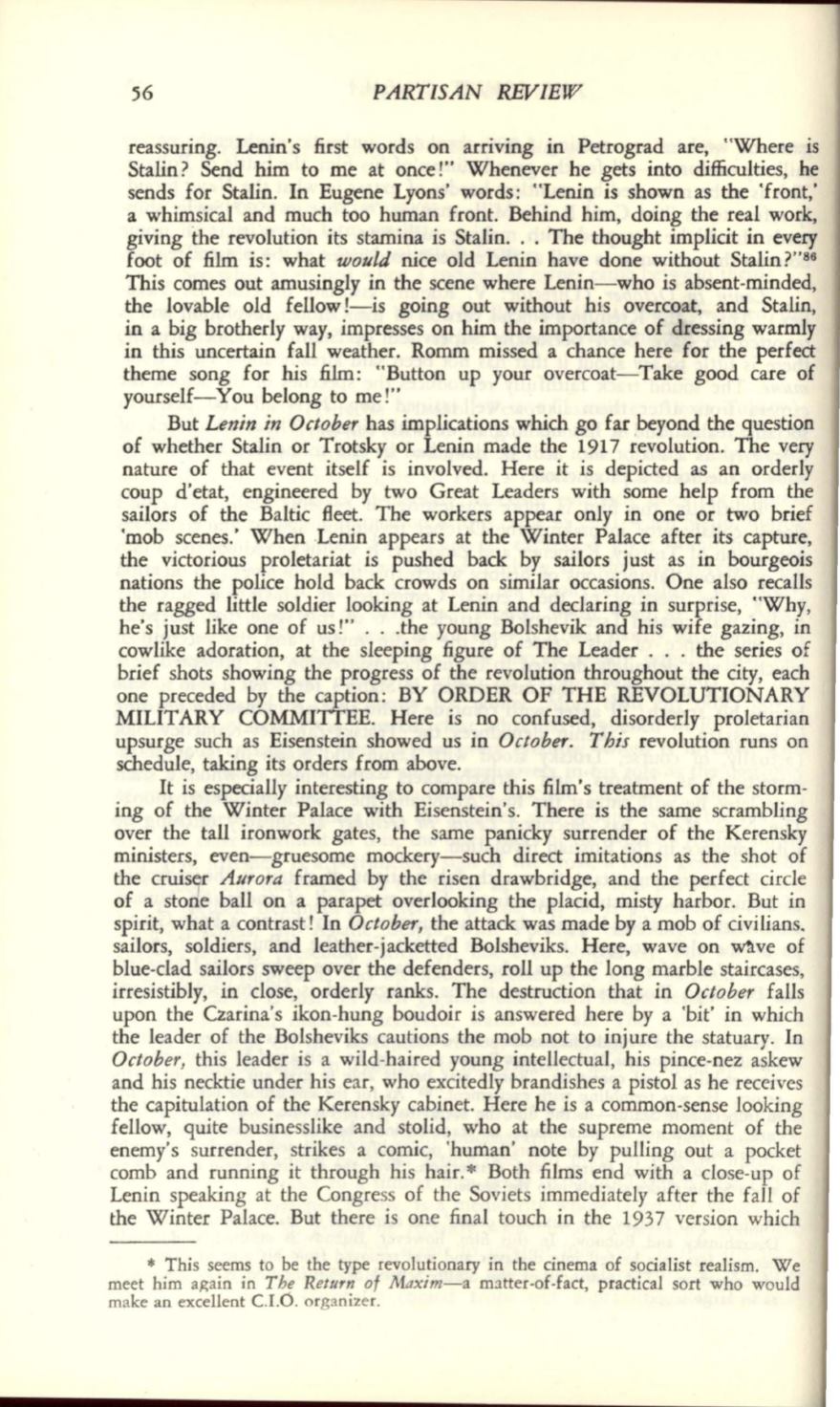
56
PARTISAN REVIEW
reassuring. Lenin's first words on arriving in Petrograd are, "Where is
Stalin? Send him to me at once!" Whenever he gets into difficulties, he
sends for Stalin. In Eugene Lyons' words: "Lenin is shown as the 'front,'
a whimsical and much too human front. Behind him, doing the real work,
giving the revolution its stamina is Stalin. . . The thought implicit in every
foot of film is: what
would
nice old Lenin have done without Stalin?,,86
This comes out amusingly in the scene where Lenin-who is absent-minded,
the lovable old fellow!-is going out without his overcoat, and Stalin,
in a big brotherly way, impresses on him the importance of dressing warmly
in this uncertain fall weather. Romm missed a chance here for the perfect
theme song for his film: "Button up your overcoat-Take good care of
yourself-You belong to me!"
But
Lenin in October
has implications which go far beyond the question
of whether Stalin or Trotsky or Lenin made the 1917 revolution. The very
nature of that event itself is involved. Here it is depicted as an orderly
coup d'etat, engineered by two Great Leaders with some help from the
sailors of the Baltic fleet. The workers appear only in one or two brief
'mob scenes.' When Lenin appears at the Winter Palace after its capture,
the victorious proletariat is pushed back by sailors just as in bourgeois
nations the police hold back crowds on similar occasions. One also recalls
the ragged little soldier looking at Lenin and declaring in surprise, "Why,
he's just like one of us!" ...the young Bolshevik and his wife gazing, in
cowlike adoration, at the sleeping figure of The Leader . . . the series of
brief shots showing the progress of the revolution throughout the city, each
one preceded by the caption: BY ORDER OF THE REVOLUTIONARY
MILITARY COMMITTEE. Here is no confused, disorderly proletarian
upsurge such as Eisenstein showed us in
October. This
revolution runs on
schedule, taking its orders from above.
It
is especially interesting to compare this film's treatment of the storm–
ing of the Winter Palace with Eisenstein's. There is the same scrambling
over the tall ironwork gates, the same panicky surrender of the Kerensky
ministers, even- gruesome mockery-such direct imitations as the shot of
the cruisC1r
Aurora
framed by the risen drawbridge, and the perfect circle
of a stone ball on a parapet overlooking the placid, misty harbor. But in
spirit, what a contrast! In
October,
the attack was made by a mob of civilians.
sailors, soldiers, and leather-jacketted Bolsheviks. Here, wave on w!lve of
blue-clad sailors sweep over the defenders, roll up the long marble staircases,
irresistibly, in close, orderly ranks. The destruction that in
October
falls
upon the Czarina's ikon-hung boudoir is answered here by a 'bit' in which
the leader of the Bolsheviks cautions the mob not to injure the statuary. In
October,
this leader is a wild-haired young intellectual, his pince-nez askew
and his necktie under his ear, who excitedly brandishes a pistol as he receives
the capitulation of the Kerensky cabinet. Here he is a common-sense looking
fellow, quite businesslike and stolid, who at the supreme moment of the
enemy's surrender, strikes a comic, 'human' note by pulling out a pocket
comb and running it through his hair.
*
Both films end with a close-up of
Lenin speaking at the Congress of the Soviets immediately after the fall of
the Winter Palace. But there is one final touch in the 1937 version which
*
This seems to be the type revolutionary in the cinema of socialist realism. We
meet him again in
The Return of M(Jxim-a
m:ttter-of-fact, practical sort who would
make an excellent c.1.0. organizer.


